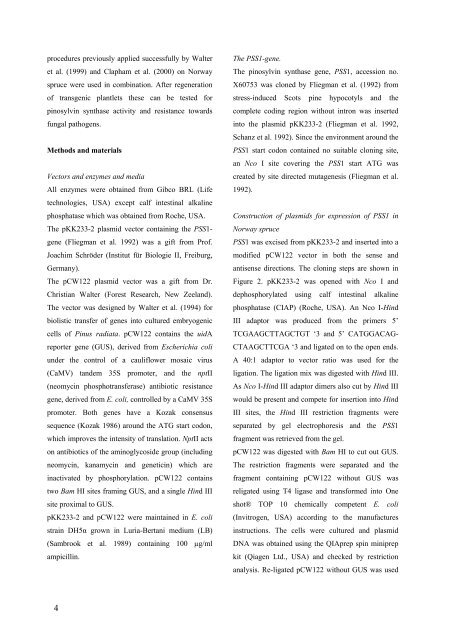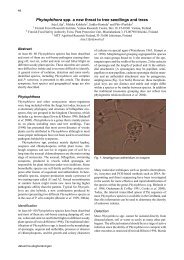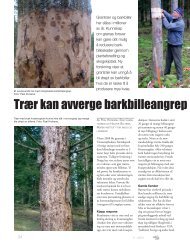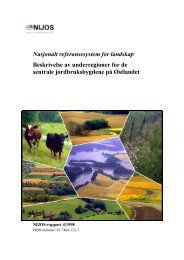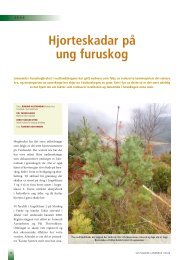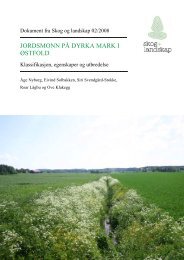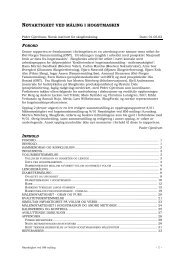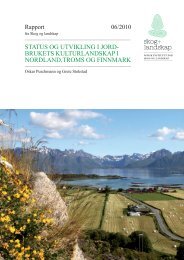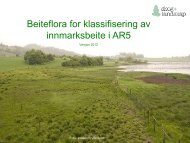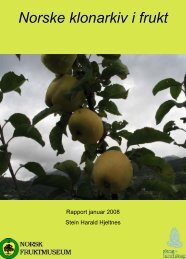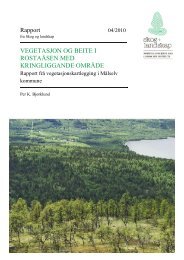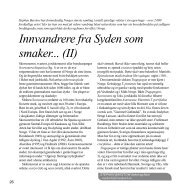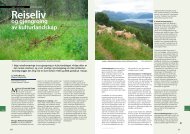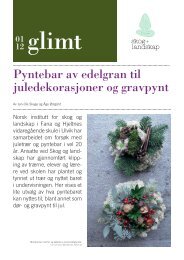Download pdf - Skog og landskap
Download pdf - Skog og landskap
Download pdf - Skog og landskap
Create successful ePaper yourself
Turn your PDF publications into a flip-book with our unique Google optimized e-Paper software.
procedures previously applied successfully by Walter<br />
et al. (1999) and Clapham et al. (2000) on Norway<br />
spruce were used in combination. After regeneration<br />
of transgenic plantlets these can be tested for<br />
pinosylvin synthase activity and resistance towards<br />
fungal path<strong>og</strong>ens.<br />
Methods and materials<br />
Vectors and enzymes and media<br />
All enzymes were obtained from Gibco BRL (Life<br />
technol<strong>og</strong>ies, USA) except calf intestinal alkaline<br />
phosphatase which was obtained from Roche, USA.<br />
The pKK233-2 plasmid vector containing the PSS1gene<br />
(Fliegman et al. 1992) was a gift from Prof.<br />
Joachim Schröder (Institut für Biol<strong>og</strong>ie II, Freiburg,<br />
Germany).<br />
The pCW122 plasmid vector was a gift from Dr.<br />
Christian Walter (Forest Research, New Zeeland).<br />
The vector was designed by Walter et al. (1994) for<br />
biolistic transfer of genes into cultured embry<strong>og</strong>enic<br />
cells of Pinus radiata. pCW122 contains the uidA<br />
reporter gene (GUS), derived from Escherichia coli<br />
under the control of a cauliflower mosaic virus<br />
(CaMV) tandem 35S promoter, and the nptII<br />
(neomycin phosphotransferase) antibiotic resistance<br />
gene, derived from E. coli, controlled by a CaMV 35S<br />
promoter. Both genes have a Kozak consensus<br />
sequence (Kozak 1986) around the ATG start codon,<br />
which improves the intensity of translation. NptII acts<br />
on antibiotics of the amin<strong>og</strong>lycoside group (including<br />
neomycin, kanamycin and geneticin) which are<br />
inactivated by phosphorylation. pCW122 contains<br />
two Bam HI sites framing GUS, and a single Hind III<br />
site proximal to GUS.<br />
pKK233-2 and pCW122 were maintained in E. coli<br />
strain DH5α grown in Luria-Bertani medium (LB)<br />
(Sambrook et al. 1989) containing 100 µg/ml<br />
ampicillin.<br />
4<br />
The PSS1-gene.<br />
The pinosylvin synthase gene, PSS1, accession no.<br />
X60753 was cloned by Fliegman et al. (1992) from<br />
stress-induced Scots pine hypocotyls and the<br />
complete coding region without intron was inserted<br />
into the plasmid pKK233-2 (Fliegman et al. 1992,<br />
Schanz et al. 1992). Since the environment around the<br />
PSS1 start codon contained no suitable cloning site,<br />
an Nco I site covering the PSS1 start ATG was<br />
created by site directed mutagenesis (Fliegman et al.<br />
1992).<br />
Construction of plasmids for expression of PSS1 in<br />
Norway spruce<br />
PSS1 was excised from pKK233-2 and inserted into a<br />
modified pCW122 vector in both the sense and<br />
antisense directions. The cloning steps are shown in<br />
Figure 2. pKK233-2 was opened with Nco I and<br />
dephosphorylated using calf intestinal alkaline<br />
phosphatase (CIAP) (Roche, USA). An Nco I-Hind<br />
III adaptor was produced from the primers 5’<br />
TCGAAGCTTAGCTGT ‘3 and 5’ CATGGACAG-<br />
CTAAGCTTCGA ‘3 and ligated on to the open ends.<br />
A 40:1 adaptor to vector ratio was used for the<br />
ligation. The ligation mix was digested with Hind III.<br />
As Nco I-Hind III adaptor dimers also cut by Hind III<br />
would be present and compete for insertion into Hind<br />
III sites, the Hind III restriction fragments were<br />
separated by gel electrophoresis and the PSS1<br />
fragment was retrieved from the gel.<br />
pCW122 was digested with Bam HI to cut out GUS.<br />
The restriction fragments were separated and the<br />
fragment containing pCW122 without GUS was<br />
religated using T4 ligase and transformed into One<br />
shot® TOP 10 chemically competent E. coli<br />
(Invitr<strong>og</strong>en, USA) according to the manufactures<br />
instructions. The cells were cultured and plasmid<br />
DNA was obtained using the QIAprep spin miniprep<br />
kit (Qiagen Ltd., USA) and checked by restriction<br />
analysis. Re-ligated pCW122 without GUS was used


